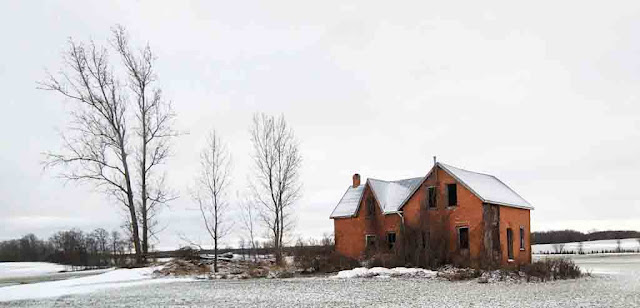On Saturday we went for a countryside drive, ostensibly to hunt for Snowy Owls. We didn't see any, but what we did see was a rapidly changing rural landscape. Traditional farms are gone and cash cropping in a depopulated landscape has taken over. I never recognized this so very clearly before.
I also took far too many pictures, so I eventually divided this into two posts.
The landscape we drove through was incredibly clear of any buildings or fences, though straddled at one point with power lines from the Bruce Nuclear plant. We noticed first because the long grass that marks the fencerows is a great place to look for owls, but there were no fencerows!This was the only 'conventional' farm I got a picture of, a farm with a both house and barn, as every farm used to have. Though if you look closely you'll see that the barn is really a large driveshed, typical of a cash crop operation, no animals in sight.
Of course there are still some beautiful big farmhouses, this one of the nicest, but either there is no barn left or the fields are simply rented out, so this is one of a few rural non-farm residences.
There are a few barns that appear to be actively used, with manure in the barnyard - but no farmhouse.
And houses are usually absent entirely, though this one was simply abandoned - what was once a busy farm home.










It is changing here too. So sad to see. Great photos.
ReplyDeleteYes, manure in the barnyard is always a good clue tthat farm animals are nearby. Whenever I see abandoned buildings I always think of the stories they could tell and especially those scattered about the countryside.
ReplyDeleteFarmers work so hard and get little reward for it. I can see why the lucrative purchase offers would be tempting. It is still quite startling to see your shots though.
ReplyDeleteExcellent countryside to be out and about in.
ReplyDelete100 acre farm, that was the size of my Dad's and Mum's farm where I grew up. Now, it is all divided into 4 acre blocks or so, with gated entrances, push a keypad to enter, HUGE homes, no crops or animals at all, ,most are what I call ultra luxurious. Those homes that are left or demolished, what a shame to see them fall down, not repaired or even moved.Signs of how everyone lives or makes a living these days. The snow on the ground, a little sparse in places, sorry about the owls.Lovely views in every photo.
ReplyDeleteThat's what has happened over large parts of East Anglia. Around here there are far too many signs proclaiming that the land is now owned by PX Farms, an organisation with a negative reputation for looking after the countryside.
ReplyDeleteSnowy Owls are hard to find this year.
ReplyDeleteI enjoyed both your photos and thoughts, which I personally have never thought about before. I haven’t noticed such a depopulation here, but I don’t really notice much. 😀
ReplyDeleteI always think of you when I see a barn and farmhouse. It's interesting to see how they have changed over the decades. I look forward to your next post, too.
ReplyDeleteSo sorry no fence rows for the snowy owls. A lot of land no longer owned by individual farmers, and many of the next generations moved away so when the older farmers died, the houses were just deserted. At least one of those derilict houses looks like the ground in front of it had been plowed for some grassy crop - fourth photo from end.
ReplyDeleteShame no owls but I did enjoy seeing your photographs.
ReplyDeleteAll the best Jan
Sad, sad, sad.
ReplyDelete